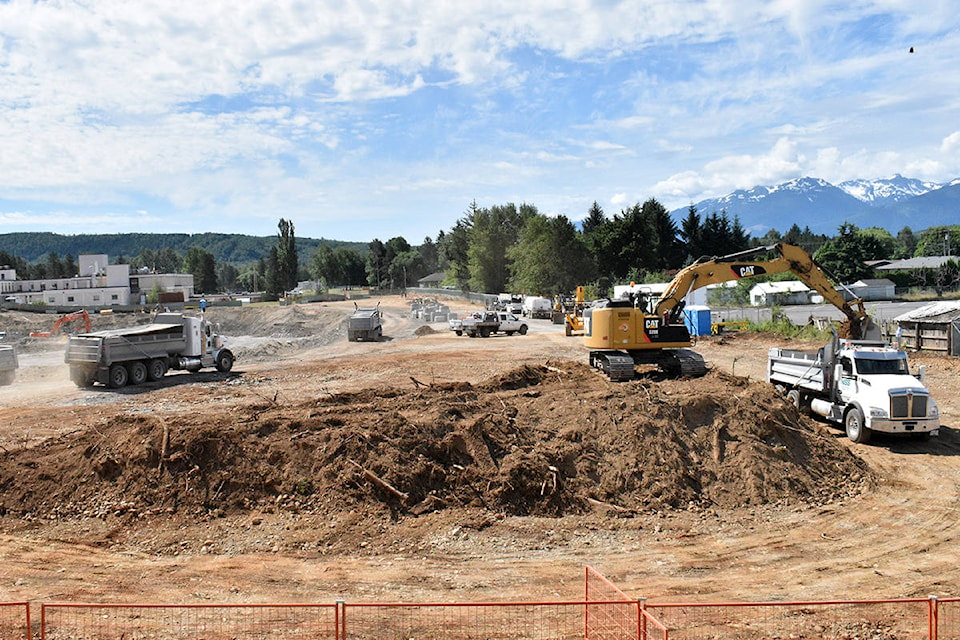Construction of the new Mills Memorial Hospital and accompanying Seven Sisters mental health facility is expected to generate just over 2,650 person years of employment with the peak of activity to be two years from now in summer 2023.
More than half of that total, or 1,590 person years of employment, will be in direct employment and the remainder in indirect employment, health minister Adrian Dix said last week.
And while contractor PCL Constructors Westcoast has committed itself to hiring as many local people as possible, there’s no figure it must reach, he said.
“I would expect PCL to want to hire locally. There is an advantage to the company. Doing so would save travel costs, accommodation costs of bringing people in,” Dix added in outlining the financial incentive to the company.
But Dix did acknowledge that a majority of the construction workforce will come from elsewhere.
“It’s a question of the need for a skilled workforce,” he said of specialized workers needed for projects as complex as constructing a health care facility.
Overall, PCL estimates up to 20 per cent of its construction workforce will come from the northwest.
As one sign of the number of out-of-town workers and those from around the region PCL will bring in, a work camp to hold up to 350 people is now under construction on lands belonging to the Kitsumkalum First Nation. It had unsuccessfully looked at other locations, including land at the Skeena Industrial Development Park south of the Northwest Regional Airport.
Northern Health is also set to track the number of local versus out of town workers.
Information provided through the Northern Health Authority indicates PCL will reach that 350 employee figure in the summer of 2023, a period being described as the peak of construction.
PCL also expects that 900 jobs will be created at one time or another for varying lengths of time over the life of the project.
The camp consisting of modular housing and other units is being provided by Alberta contractor Pinion Contracting and is located on the site of a former sawmill along the West Kalum Forest Service Road, a few kilometres in from Hwy 16 just before the turnoff to the Kitsumkalum village site.
In itself, 40 people are expected to be employed through the camp in security, administrative, housekeeping, kitchen and janitorial duties.
Aside from direct construction and construction-related employment, both Northern Health and the health ministry are saying there will be additional jobs in commissioning the new structure and readying it for occupancy.
The completion date is to be late 2025 followed by the demolishing of the current hospital.
Dix said he was not terribly surprised that the first project cost of $447.5 million, set in 2019 when the government gave its go ahead approval, rose to $622.6 million, a 40 per cent jump.
With that increase, the new Mills will be the largest direct expenditure by the provincial government in the history of northern B.C.
Information provided to him by his officials indicated electrical and mechanical costs had increased by the same approximate percentage over the past two years.
“We’re in a very robust economy with a very robust labour force,” Dix said of the construction climate affecting projects of all kinds.
Some people may have said to hold off on the construction in hopes of costs lowering, but Dix said that wasn’t feasible given the age of the current Mills.
“We need to build the new hospital now and that’s what we’re doing,” he said.
Dix added that he is comfortable the new price tag will hold firm, saying provincial officials examined costs closely in negotiating with PCL.
“This is a fixed price, the financial risk has been passed to PCL,” he said.
And at $622.6 million, the new Mills is not only the largest construction project ever in Northern Health, it is also the largest direct expenditure by the provincial government in the history of the north.
The cost increase will be borne by the provincial government and not shared with northwestern B.C. property owners who pay property taxes to the North West Regional Hospital District for health care equipment and facilities.
That’s because the hospital district successfully negotiated a deal in 2019 limiting regional taxpayers to 30 per cent of the project cost to a maximum dollar cap of $113.7 million, a figure that includes the $3.5 million spent on development the business plan for the project.
Traditionally, regional hospital districts pay 40 per cent of capital projects but the regional hospital directors went into negotiations wanting to pay 20 per cent, something not accepted by the province. Both sides eventually settled on the 30 per cent limit.
That 20 per cent request did match what property owners in the Stuart-Nechako Regional Hospital District negotiated when the new hospital was built in Burns Lake in the middle of the last decade.
Based on the $113.7 million cap and the new price of $622.6 million, the regional property owner tax exposure works out to 18.26 per cent.
